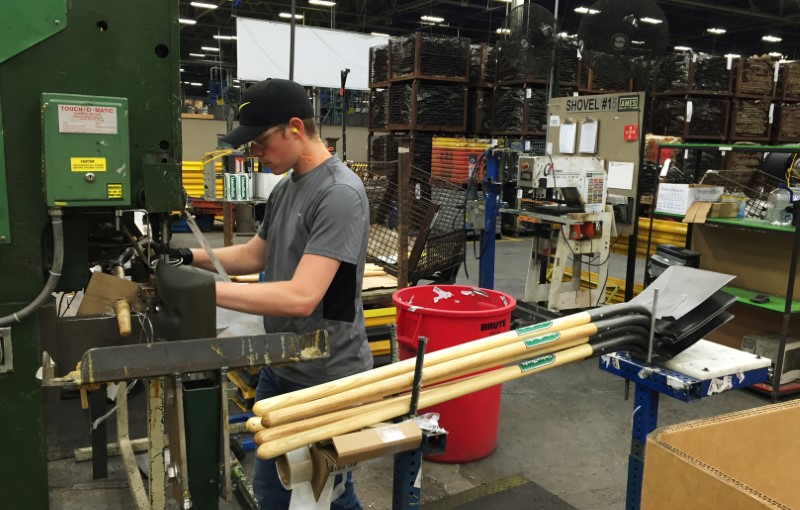WASHINGTON (Reuters) – U.S. manufacturing activity contracted less than expected in March, but disruptions caused by the coronavirus pandemic pushed new orders received by factories to an 11-year low, reinforcing economists’ views that the economy was in recession.
The economy’s outlook was further dimmed by other data on Wednesday showing private payrolls dropped last month for the first time in 2-1/2 years as businesses shut down in compliance with strict measures to contain the highly contagious virus.
The grim economic picture has forced the Federal Reserve to take extraordinary measures, and President Donald Trump last Friday signed a $2.2 trillion stimulus package.
“Manufacturing is back in recession, joining the rest of the economy,” said Chris Rupkey, chief economist at MUFG in New York. “With only a few actual data points so far, the results indicate this is looking more like a depression than a garden-variety recession.”
The Institute for Supply Management (ISM) said its index of national factory activity fell to a reading of 49.1 last month from 50.1 in February. A reading below 50 indicates contraction in the manufacturing sector, which accounts for 11% of the U.S. economy. Economists polled by Reuters had forecast the index would drop to 45.0 in March.
The smaller-than-expected drop in the ISM index reflected a jump in the survey’s measure of supplier deliveries to a reading of 65.0 this month from 57.3 in February. A lengthening in suppliers’ delivery times is normally associated with increased activity, which would be a positive contribution to the index. But in this case slower supplier deliveries indicate supply shortages related to the coronavirus pandemic and not stronger demand.
The ISM said comments from manufacturers “were negative regarding the near-term outlook, with sentiment clearly impacted by the coronavirus pandemic and energy market volatility.”
More than 80% of Americans are under some form of lockdown as states and local governments try to contain the spread of the virus, bringing the nation to an abrupt stop. The United States has the highest number of confirmed cases of COVID-19, the respiratory illness caused by the virus, with nearly 188,000 people infected. Almost 4,000 people in the country have died from the illness, according to a Reuters tally.
As well as causing disruptions in supply chains, the pandemic has shut down demand, with the transportation industry almost crawling to a halt, and restaurants, bars and other social venues shutting.
Those business closures resulted in private payrolls falling by 27,000 jobs last month, the first decline since September 2017, the ADP National Employment Report showed separately on Wednesday. Private payrolls advanced by an unrevised 183,000 in February. The payrolls drop in March was concentrated among small businesses, while larger companies added workers.
“Looking ahead, the timing and strength of the recovery is highly uncertain so long as major parts of the domestic economy are on virtual lockdown and external demand remains in the doldrums,” said Oren Klachkin, lead economist at Oxford Economics in New York.
Economists had forecast private payrolls would fall by 150,000 jobs in March. The smaller-than-expected decline was due to establishments being surveyed in mid-March, before many states and local governments ordered residents to stay at home unless on essential business.
The dollar <.DXY> was trading higher against a basket of currencies. U.S. Treasury prices were mostly higher. Major indexes on Wall Street tumbled on the data and Trump’s warning on Tuesday that the country faced a tough two weeks ahead in its battle against the coronavirus.[
LABOR MARKET DETERIORATING
The ADP report, jointly developed with Moody’s Analytics, was published ahead of the government’s more comprehensive employment report for March, which is scheduled for release on Friday. While it has a poor record predicting the private payrolls component of the government’s employment report because of methodology differences, economists said it could offer some clues on the size of anticipated job losses in March.
Economists believe the longest employment boom in U.S. history, which started October 2010, came to an end in March.
According to a Reuters survey of economists, the government report on Friday is likely to show nonfarm payrolls dropped by 100,000 jobs last month after a robust increase of 273,000 in February. The unemployment rate is forecast to rise three-tenths of a percentage point to 3.8% in March.
The National Bureau of Economic Research, the private research institute regarded as the arbiter of U.S. recessions, does not define a recession as two consecutive quarters of decline in real gross domestic product, as is the rule of thumb in many countries. Instead, it looks for a drop in activity, spread across the economy and lasting more than a few months.
The ISM’s forward-looking new orders sub-index dropped to a reading of 42.2 in March, the lowest since March 2009, from 49.8 in February. Manufacturers also reported paying less for raw materials and other inputs. The survey’s measure of factory employment decreased to a reading of 43.8 last month, the lowest since May 2009, from 46.9 in February.
The deteriorating labor market picture is likely to be underscored by the Labor Department’s weekly jobless claims report on Thursday, which is expected to show the number of Americans filing claims for unemployment benefits hit a new all-time high last week after vaulting to a record 3.28 million in the week ended March 21.
“The recently-enacted stimulus will help limit the damage, but many small businesses will lay off most or all of their workers, at least temporarily, during the recession,” said Gus Faucher, chief economist at PNC Financial in Pittsburgh.
(Reporting by Lucia Mutikani; Editing by Chizu Nomiyama and Paul Simao)






















